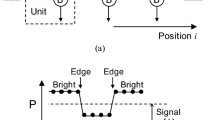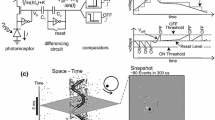Abstract
A simplified model was proposed for the formation of edge signals and generation of motion signals of a target based on the information processing mechanisms of outer and inner retinas of a vertebrate. Analog metal-oxide-silicon (MOS) integrated circuits were designed based on the model. Simulation program with integrated circuit emphasis (SPICE) simulation results showed the performance of local adaptation over a wide dynamic range in the outer retinal circuit and generation of the velocity signal of a moving edge in the inner retinal circuit. Preliminary experimental results showed local adaptation in a given input range in the outer retinal circuit and the generation of motion pulsed signals in the inner retinal circuit.
Similar content being viewed by others
References
C. A. Mead: Analog VLSI and Neural Systems (Addison Wesley, Reading, MA, 1989) p. 257.
C. A. Mead and M. A. Mahowald: Neural Networks 1 (1988) 91.
T. Delbr$uUck and C. Mead: Comput. Neural Syst. Program 30 (1994) 1.
H. Ikeda, K. Tsuji, T. Asai, H. Yonezu and J. K. Shin: IEEE Photonics Technol. Lett. 10 (1998) 261.
C. Wu and C. Chiu: IEEE J. Solid-State Circuits 30 (1995) 890.
C. M. Higgins, R. A. Deutschmann and C. Koch: IEEE Trans. Circuits Syst. II46 (1999) 677.
K. Boahen: Proceedings of the 7th International Conference on Microelectronics for Neural, Fuzzy, and Bio-Inspired Systems (Granada, Spain, 1999) p. 12.
H. Kolb: Eye 11 (1997) 904.
M. R. Ibbotson, C. W. G. Clifford and R. F. Mark: J. Neurophysiol. 79 (1998) 1481.
K. Nishio, M. Ohtani, H. Yamada, A. Takasaki, Y. Furukawa, H. Yonezu, M. Lee and J. K. Shin: Proceedings of 6th International Conference on Soft Computing and Information (Fukuoka, Japan, 2000) p. 718.
Author information
Authors and Affiliations
Corresponding author
Rights and permissions
About this article
Cite this article
Yamada, H., Miyashita, T., Ohtani, M. et al. Signal Formation of Image-Edge Motion Based on Biological Retinal Networks and Implementation into an Analog Metal-Oxide-Silicon Circuit. OPT REV 8, 336–342 (2001). https://doi.org/10.1007/s10043-001-0336-6
Received:
Accepted:
Issue Date:
DOI: https://doi.org/10.1007/s10043-001-0336-6




